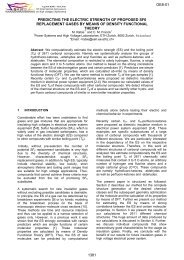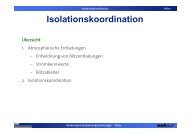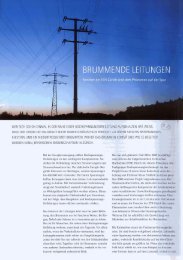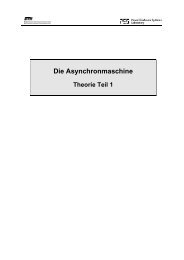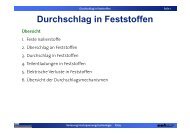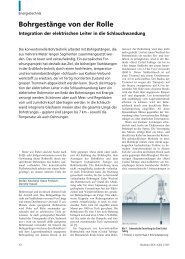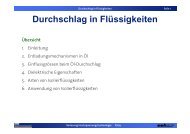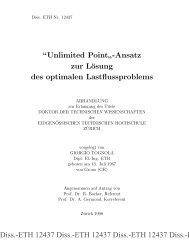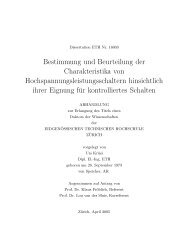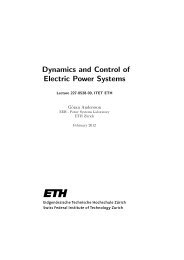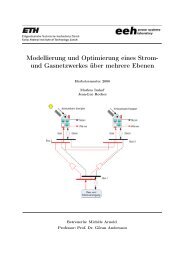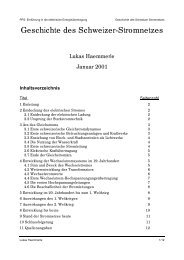Ruben Vogelsang Time to breakdown of high voltage winding ... - EEH
Ruben Vogelsang Time to breakdown of high voltage winding ... - EEH
Ruben Vogelsang Time to breakdown of high voltage winding ... - EEH
Erfolgreiche ePaper selbst erstellen
Machen Sie aus Ihren PDF Publikationen ein blätterbares Flipbook mit unserer einzigartigen Google optimierten e-Paper Software.
<strong>Ruben</strong> <strong>Vogelsang</strong><br />
<strong>Time</strong> <strong>to</strong> <strong>breakdown</strong> <strong>of</strong> <strong>high</strong> <strong>voltage</strong><br />
<strong>winding</strong> insulations with respect <strong>to</strong><br />
microscopic properties and<br />
manufacturing qualities<br />
Σ<br />
Hartung-Gorre Verlag Konstanz, Germany, 2004
<strong>Ruben</strong> <strong>Vogelsang</strong>, Dissertation ETH No.15656<br />
ISBN: 3-89649-965-3<br />
Abstract<br />
High <strong>voltage</strong> rotating machines remain <strong>to</strong> play a significant role in generating electrical<br />
energy as the demand for new or refurbishment <strong>of</strong> power stations continues <strong>to</strong> increase.<br />
However, one <strong>of</strong> the main causes for down times in <strong>high</strong> <strong>voltage</strong> rotating machines is<br />
related <strong>to</strong> problems with the <strong>winding</strong> insulation. The deregulated and liberalised energy<br />
market leads <strong>to</strong> cost pressure on the producers <strong>of</strong> the insulation materials and on the<br />
utilities. Manufacturers are requesting <strong>winding</strong> insulations that can withstand a <strong>high</strong>er<br />
electric field than the 2 – 3 kV/mm common <strong>to</strong>day while keeping the costs low. The<br />
utilities want <strong>to</strong> reduce costs through longer maintenance intervals and a <strong>high</strong>er lifetime <strong>of</strong><br />
the machines. These demands create a challenge for the producers <strong>of</strong> <strong>winding</strong> insulations,<br />
the manufacturers <strong>of</strong> <strong>high</strong> <strong>voltage</strong> rotating machines and the utilities and were therefore a<br />
reason <strong>to</strong> carry out this project.<br />
Although, electrical degradation and <strong>breakdown</strong> in polymers has been studied extensively,<br />
the processes that lead <strong>to</strong> failure in <strong>high</strong> <strong>voltage</strong> <strong>winding</strong> insulations have still not been<br />
conclusively described. In particular, the influences <strong>of</strong> the numerous combinations <strong>of</strong><br />
different raw materials, mica tapes, manufacturing qualities and service loads on the<br />
material properties and on time <strong>to</strong> <strong>breakdown</strong> are not fully unders<strong>to</strong>od. Since the material<br />
effort for testing insulations with the standard test method (IEEE 1043 Std) is very <strong>high</strong>,<br />
only few results <strong>of</strong> tests <strong>of</strong> <strong>winding</strong> insulations are available, each having a low number <strong>of</strong><br />
samples and therefore a <strong>high</strong> statistical uncertainty.<br />
Therefore, the main fac<strong>to</strong>rs that influence time <strong>to</strong> <strong>breakdown</strong> <strong>of</strong> <strong>high</strong> <strong>voltage</strong> <strong>winding</strong><br />
insulations were analysed in this work. It was concentrated on describing the influences <strong>of</strong><br />
raw materials, mica tapes, manufacturing qualities and selected service loads on the<br />
microscopic properties and on time <strong>to</strong> <strong>breakdown</strong> <strong>of</strong> the insulations.<br />
The analysis <strong>of</strong> microscopic properties <strong>of</strong> mica tapes in <strong>winding</strong> insulations show that the<br />
tapes are circularly bent at the edges <strong>of</strong> the conduc<strong>to</strong>r, at voids or within the insulation. In<br />
addition, the mica tapes are bent at regions <strong>of</strong> tape overlappings. Investigations in model<br />
needle-plane arrangements show that the electrical tree cannot penetrate a mica tape if it is<br />
undis<strong>to</strong>rted. In contrast, the tree can penetrate circularly bent tapes, whereby the<br />
iii
<strong>Ruben</strong> <strong>Vogelsang</strong>, Dissertation ETH No.15656<br />
probability for penetrating the tapes decreases with increasing radius. For tape overlappings,<br />
the probability <strong>of</strong> the tree penetrating the tapes decreases with increasing apex<br />
angle. <strong>Time</strong> <strong>to</strong> <strong>breakdown</strong> can significantly be reduced when the tree penetrates the tape.<br />
The cause for the tree penetrating the bent tape is a <strong>high</strong>er degree <strong>of</strong> separation <strong>of</strong> the mica<br />
flakes at stronger bending. Thereby, the tree propagates more easily through the separated<br />
flakes, which leads <strong>to</strong> a shorter <strong>breakdown</strong> path and <strong>to</strong> a significantly reduced time <strong>to</strong><br />
<strong>breakdown</strong>. Tapes with glass fabric as a support material are more flexible, which resulted<br />
in less tree penetrations than tapes with PETP-film. For manufacturers <strong>of</strong> <strong>winding</strong><br />
insulations, it can be concluded that tape bends should be minimised (e.g. by applying<br />
tapes with a <strong>high</strong>er width). If bends cannot be avoided, such as at the conduc<strong>to</strong>r edge, their<br />
radius should be as <strong>high</strong> as possible. As the tree could penetrate all tapes at radii <strong>of</strong><br />
≤ 1mm, the value for tape bends in the insulations must have a minimum <strong>of</strong> > 1 mm. For<br />
<strong>winding</strong> insulations in which more tape bends are expected (e.g. poor manufacturing<br />
qualities), tapes with glass fabric as support material are recommended for application.<br />
Electrical tree propagation is the main process that leads <strong>to</strong> <strong>breakdown</strong> in <strong>high</strong> <strong>voltage</strong><br />
<strong>winding</strong> insulations. Due <strong>to</strong> a significantly enhanced electric field in voids at the inner<br />
conduc<strong>to</strong>r or at the outer coating, the time interval for tree inception in the bars is<br />
negligibly low. After inception, the tree propagates through the insulation along the mica<br />
tapes at the interfaces mica-support material-binder resin. Tree propagation is reduced in<br />
insulations with a <strong>high</strong>er number <strong>of</strong> tape layers and <strong>high</strong>er mica content. In order <strong>to</strong><br />
increase time <strong>to</strong> <strong>breakdown</strong> (or lifetime) <strong>of</strong> <strong>winding</strong> insulations, it is concluded that tree<br />
inception should be delayed and tree propagation must be slowed down. Tree inception<br />
can be delayed by preventing voids at the conduc<strong>to</strong>r (e.g. by using a tape with <strong>high</strong>er resin<br />
content in the first layer) or by applying a conductive layer at the inner conduc<strong>to</strong>r. To slow<br />
down tree propagation, the mica content and the number <strong>of</strong> tape layers <strong>of</strong> the main wall<br />
insulation must be as <strong>high</strong> as possible. Therefore, more layers <strong>of</strong> thinner mica tapes are<br />
recommended for use.<br />
In order <strong>to</strong> measure the tree propagation through the material, a test was developed that<br />
requires much less material than the conventional test according <strong>to</strong> IEEE 1043 Std. Using<br />
that treeing test with an embedded electrode, significant differences in the insulation<br />
properties can be identified. A further advantage is that the electrode can be implanted in a<br />
determined region <strong>of</strong> the insulation, which allows testing insulation properties at certain<br />
sections <strong>of</strong> the bar. As the test can also be applied at bars that were already produced, it is<br />
very easily applicable and can be recommended for tests where only a low number <strong>of</strong><br />
samples are accessible, which might be due <strong>to</strong> time, cost or material reasons.<br />
At manufacturing, impregnation and the type <strong>of</strong> taping play an important role <strong>to</strong>wards the<br />
insulation quality. A lower impregnation quality causes voids and delaminations in the<br />
material, which results in significantly reduced time <strong>to</strong> <strong>breakdown</strong> values. The degree <strong>of</strong><br />
reduction depends on the material, whereby mica tapes with glass fabric are less sensitive<br />
for impregnation failure, than tapes with PETP-film as a support material. The influence<br />
<strong>of</strong> taping on time <strong>to</strong> <strong>breakdown</strong> was investigated on industrially-manufactured insulations<br />
directly from the production line <strong>of</strong> different companies. Insulations that were taped by<br />
machine have a structure without any voids or delaminations and therefore no significant<br />
differences in the time <strong>to</strong> <strong>breakdown</strong> values, compared <strong>to</strong> the reference material. In<br />
contrast, insulations that were taped by hand tend <strong>to</strong> have a lower insulation quality, which<br />
may lead <strong>to</strong> a dramatic decrease in time <strong>to</strong> <strong>breakdown</strong> compared <strong>to</strong> the reference material.<br />
The 63%-quantile <strong>of</strong> time <strong>to</strong> <strong>breakdown</strong> <strong>of</strong> a hand-taped VPI-insulation was reduced by<br />
more than two orders <strong>of</strong> magnitude and that <strong>of</strong> a resin rich insulation by more than four<br />
orders <strong>of</strong> magnitude! Both insulation systems showed an internal quality with many voids<br />
and delaminations between the mica tapes. Electrical trees could therefore propagate very<br />
ISBN: 3-89649-965-3<br />
iv
<strong>Ruben</strong> <strong>Vogelsang</strong>, Dissertation ETH No.15656<br />
quickly along the tapes, thus leading <strong>to</strong> the early <strong>breakdown</strong>. Considering the materials,<br />
resin rich insulations are more sensitive <strong>to</strong> manufacturing failures than VPI-insulations as<br />
their time <strong>to</strong> <strong>breakdown</strong> values were vastly reduced at both, poor impregnation and poor<br />
taping quality. In conclusion, machine taping is strongly recommended for the wrapping<br />
<strong>of</strong> mica tapes. If hand taping shall be used, VPI-tapes with glass fabric as support material<br />
are less sensitive for poor taping quality and should therefore be applied. In order <strong>to</strong><br />
ensure good quality during production, electrical treeing tests with the embedded electrode<br />
are recommended for checking the insulation quality in the production line at regular<br />
intervals.<br />
Although time <strong>to</strong> <strong>breakdown</strong> values <strong>of</strong> insulations with poor quality is significantly lower<br />
than the values for the reference material, most <strong>of</strong> the bars would have passed the standard<br />
“One minute pro<strong>of</strong> test” according <strong>to</strong> IEC 60243-1 Std and IEC 1212.2 Std. At three times<br />
the rated <strong>voltage</strong>, <strong>breakdown</strong> in poor insulations occurred within a few minutes, whereas<br />
in good insulations it occurred in some tens <strong>of</strong> hours up <strong>to</strong> about 5,000 hours. It is<br />
therefore recommended <strong>to</strong> extend the time interval <strong>of</strong> the “One minute pro<strong>of</strong> test” <strong>to</strong><br />
> 10 min. Insulations with a poor quality would thereby be tested out and insulations with<br />
a good quality would experience no significant degradation.<br />
At elevated temperatures, the VPI-insulation showed, compared <strong>to</strong> 20 °C, an increase in<br />
time <strong>to</strong> <strong>breakdown</strong> at 160 °C and a decrease at 180 °C. In contrast, the resin rich insulation<br />
showed, compared <strong>to</strong> 20 °C, a decrease <strong>of</strong> time <strong>to</strong> <strong>breakdown</strong> at both, 160 and 180 °C. The<br />
different <strong>breakdown</strong> behaviour <strong>of</strong> the materials can be related <strong>to</strong> the relief <strong>of</strong> mechanical<br />
strain <strong>of</strong> the bars, the different materials <strong>of</strong> the mica tapes and the expansion <strong>of</strong> the<br />
material. At temperatures <strong>of</strong> 180 °C, PETP-film as support material is critical since it<br />
degrades and leads <strong>to</strong> faster tree propagation, which finally causes a significant decrease<br />
<strong>of</strong> time <strong>to</strong> <strong>breakdown</strong>. For the operation <strong>of</strong> the insulations it is concluded that elevated<br />
temperatures are only critical if they are close or above the glass transition temperature <strong>of</strong><br />
the material. Operating at that temperature level, or hot spots in the insulation, should<br />
therefore be avoided or minimised. Since there is an increase <strong>of</strong> time <strong>to</strong> <strong>breakdown</strong>, the<br />
operation at slightly elevated temperatures should be considered.<br />
At mechanical vibrations between ± 0.15 and ± 0.80 mm, time <strong>to</strong> <strong>breakdown</strong> is mainly<br />
dependent on the vibration frequency and the material used rather than on the <strong>to</strong>tal number<br />
<strong>of</strong> vibrations. For both materials, the <strong>high</strong>est reduction <strong>of</strong> time <strong>to</strong> <strong>breakdown</strong> was<br />
measured at the <strong>high</strong>est vibration frequency <strong>of</strong> the bars <strong>of</strong> 50 Hz. The reason for the<br />
decrease is that the epoxy resin in the insulation becomes porous, which gives way <strong>to</strong> fast<br />
tree propagation and finally results in significantly reduced time <strong>to</strong> <strong>breakdown</strong> values. For<br />
both, VPI and resin rich insulations, it can be concluded that mechanical vibrations are<br />
very critical and must therefore be absolutely avoided in the machines.<br />
Overall, it can be concluded that the manufacturing quality <strong>of</strong> <strong>high</strong> <strong>voltage</strong> <strong>winding</strong> insulations<br />
plays a major role <strong>to</strong>wards microscopic properties and therefore time <strong>to</strong> <strong>breakdown</strong><br />
<strong>of</strong> <strong>winding</strong> insulations. In order <strong>to</strong> extend lifetime, more attention has <strong>to</strong> be paid <strong>to</strong> the<br />
manufacturing <strong>of</strong> the insulations. Regarding the application <strong>of</strong> the two main insulation<br />
systems VPI and resin rich, it can be stated that the microscopic properties <strong>of</strong> resin rich<br />
insulations have the <strong>high</strong>er potential for longer lifetime expectancy. However, these<br />
materials are more sensitive <strong>to</strong> any kind <strong>of</strong> failure during manufacturing and service load.<br />
In contrast, VPI-materials have generally a lower potential for long lifetime expectancy,<br />
but are more <strong>to</strong>lerant <strong>to</strong> manufacturing failures and therefore more easily applicable.<br />
ISBN: 3-89649-965-3<br />
v
<strong>Ruben</strong> <strong>Vogelsang</strong>, Dissertation ETH No.15656<br />
ISBN: 3-89649-965-3<br />
Kurzfassung<br />
Aufgrund der weltweit steigenden Nachfrage nach neuen oder instand zu setzenden<br />
Kraftwerken, bleiben rotierende Hochspannungsmaschinen ein wichtiges Element in der<br />
elektrischen Energieversorgung. Etwa ein Viertel aller Ausfallzeiten von Kraftwerken sind<br />
jedoch auf Probleme in Wicklungsisolierungen zurückzuführen. Im deregulierten und<br />
liberalisierten Energiemarkt spielen Kosten sowohl für Hersteller von Hochspannungsmaschinen<br />
als auch für Energieversorger eine immer bedeutendere Rolle. Die Hersteller<br />
der Maschinen verlangen nach kostengünstigen Wicklungsisolierungen, die bei höheren<br />
Feldstärken als den heute üblichen 2 – 3 kV/mm arbeiten. Die Energieversorger möchten<br />
ihre Kosten durch geringere Wartungsintervalle und eine höhere Lebensdauer der<br />
Maschinen reduzieren. Diese Forderungen bilden eine Herausforderung für die Hersteller<br />
von Wicklungsisolierungen, von Hochspannungsmaschinen aber auch für die Energieversorgungsunternehmen<br />
und haben zur Initiierung des vorliegenden Projektes geführt.<br />
Obwohl zum elektrischen Durchschlag in polymeren Isoliers<strong>to</strong>ffen bereits viele Forschungen<br />
durchgeführt wurden, sind die Prozesse, welche zum Ausfall von Wicklungen in<br />
rotierenden Hochspannungsmaschinen führen, noch nicht vollständig aufgezeigt.<br />
Insbesondere sind die Einflüsse der zahlreichen Kombinationen aus Rohmaterialien,<br />
Glimmerbändern, Herstellungsverfahren und –qualitäten sowie der Belastungen im<br />
Betrieb auf die Materialeigenschaften und damit auf die Durchschlagzeiten nicht<br />
vollumfänglich bekannt. Prüfungen nach der Standardmethode IEEE 1043 Std bedingen<br />
einen sehr hohen Materialaufwand. Daher existieren nur wenige Resultate von Lebensdauerversuchen<br />
an Wicklungsisolierungen, welche aufgrund der geringen Probenanzahl<br />
eine hohe statistische Unsicherheit aufweisen.<br />
Aus den genannten Gründen wurden die wichtigsten Einflussfak<strong>to</strong>ren auf die Durchschlagzeit<br />
von Wicklungsisolierungen rotierender Hochspannungsmaschinen untersucht<br />
und in der vorliegenden Arbeit beschrieben. Dabei wurde der Schwerpunkt darauf gelegt,<br />
die Einflüsse der verschiedenen Rohmaterialien, Glimmerbänder, Herstellungsverfahren<br />
und –qualitäten sowie ausgewählter Betriebsparameter auf die Materialstruktur und damit<br />
auf die Durchschlagzeit der Isolierungen zu bestimmen.<br />
vii
<strong>Ruben</strong> <strong>Vogelsang</strong>, Dissertation ETH No.15656<br />
Die Analyse der Glimmerbänder in Wicklungsstäben zeigt, dass die Bänder an den Kanten<br />
des Innenleiters, an Gaseinschlüssen, an Bandüberlappungen sowie in der Isolierung selbst<br />
gebogen sind. Untersuchungen an Nadel-Platte-Anordnungen haben bewiesen, dass das<br />
elektrische Bäumchenwachstum (Electrical Treeing) intakte Glimmerbänder nicht durchdringen<br />
kann. Im Gegensatz dazu kann ein elektrisches Bäumchen (Electrical Tree)<br />
gebogene Glimmerbänder durchdringen. Die Wahrscheinlichkeit, dass der Tree das Band<br />
durchdringt, steigt mit kleiner werdendem Biegeradius. An Bandüberlappungen ist die<br />
Wahrscheinlichkeit, dass der Tree das Band durchdringt, bei grösserem Öffnungswinkel<br />
des Bandes geringer. Die Ursache für das Durchdringen des Bandes ist die Aufspaltung<br />
der Glimmerplättchen bei starker Biegung, wobei sich der Tree durch das Epoxidharz<br />
zwischen den aufgespaltenen Glimmerplättchen leicht ausbreiten kann. Dies führt zu<br />
einem geringeren Durchschlagweg und kann damit eine signifikant geringere Durchschlagzeit<br />
bewirken. Glimmerbänder mit Glasgewebe als Trägermaterial haben sich als<br />
flexibler erwiesen. Sie werden nicht so häufig vom Tree durchdrungen wie Bänder mit<br />
PETP-Film. Für Hersteller von Wicklungsisolierungen ergibt sich die Schlussfolgerung,<br />
dass das Auftreten von gebogenen Glimmerbändern in der Isolierung minimiert werden<br />
muss (z. B. durch die Verwendung von breiteren Glimmerbändern, was zu einer<br />
geringeren Anzahl von Bandüberlappungen führt). Für Bereiche, an denen Bandbiegungen<br />
nicht vermieden werden können, wie z. Bsp. an den Kantenradien, sollte der Biegeradius<br />
so gross als möglich sein. Da der Tree gebogene Bänder aller Materialien mit einem<br />
Radius ≤ 1 mm durchdringen konnte, sollten Bandbiegungen mindestens > 1 mm sein. Für<br />
Wicklungsisolierungen, in welchen viele Bandbiegungen zu erwarten sind (z. B. bei<br />
fehlerhafter Wickelqualität), werden Bänder mit Glasgewebe als Trägermaterial<br />
empfohlen, da sie weniger empfindlich gegenüber dem Durchdringen eines Trees sind.<br />
Der Hauptprozess, welcher in Wicklungsisolierungen rotierender Hochspannungsmaschinen<br />
zum Durchschlag führt, ist die Ausbreitung des Electrical Treeings. Ein stark<br />
überhöhtes elektrisches Feld in Gaseinschlüssen am Innen- und Aussenleiter führt zu einer<br />
vernachlässigbar geringen Zeit für den Einsatz eines Trees. Nach dem Einsatz breitet sich<br />
der Tree entlang der Glimmerbänder an den Grenzschichten Glimmer-Trägermaterial-<br />
Bindeharz aus, wobei dessen Ausbreitung in Isolierungen mit einem hohen Glimmeranteil<br />
sowie mit vielen Bandlagen langsamer verläuft. Daraus kann geschlussfolgert werden,<br />
dass für eine Erhöhung der Durchschlagzeit (Lebensdauer) von Wicklungsisolierungen der<br />
Einsatz und das Durchwachsen des Trees verlangsamt werden muss. Der Treeeinsatz kann<br />
durch das Füllen der Hohlräume am Innenleiter (z. B. die Anwendung eines Bandes mit<br />
höherem Harzanteil in der ersten Lage am Innenleiter) oder durch die Abschirmung der<br />
Hohlräume (leitfähige Schicht am Innenleiter) verzögert werden. Um das Vorwachsen des<br />
Trees zu verlangsamen, sollten der Glimmergehalt und die Anzahl der Bandlagen so hoch<br />
als möglich sein. Dazu wird empfohlen, viele Bandlagen mit dünneren Glimmerbändern<br />
zu verwenden.<br />
Um die Ausbreitung des Electrical Treeings im Material zu bestimmen, wurde ein<br />
Prüfverfahren entwickelt, welches bei gleicher statistischer Aussagekraft wesentlich<br />
weniger Material benötigt als der herkömmliche Test nach IEEE 1043 Std. Mit dem Test<br />
mit einer in das Isoliermaterial eingebrachten Elektrode können signifikante Unterschiede<br />
in den Isoliereigenschaften bestimmt werden. Ein weiterer Vorteil ist, dass die Elektrode<br />
gezielt in die Isolierung eingebracht werden kann, was die Untersuchung ausgewählter<br />
Bereiche in Wicklungsisolierungen ermöglicht. Da der Test an bereits gefertigten Stäben<br />
angewendet werden kann, ist er in der Praxis sehr leicht umsetzbar und wird daher für<br />
Untersuchungen empfohlen, bei denen aus Zeit- oder Kostengründen nur wenige Proben<br />
zur Verfügung stehen.<br />
ISBN: 3-89649-965-3<br />
viii
<strong>Ruben</strong> <strong>Vogelsang</strong>, Dissertation ETH No.15656<br />
Bei der Herstellung bestimmen die Imprägnierung sowie die Art der Bandwicklung die<br />
Qualität der Wicklungsisolierungen entscheidend. Eine ungenügende Imprägnierung<br />
verursacht Gaseinschlüsse und Delaminierungen des Bandes im Material, welche zu einer<br />
signifikant geringeren Durchschlagzeit führen. Der Grad der Reduzierung der Durchschlagzeit<br />
hängt vom verwendeten Material ab, wobei Glimmerbänder mit Glasgewebe<br />
weniger empfindlich sind als Glimmerbänder mit PETP-Film als Trägermaterial. Der<br />
Einfluss der Bandwicklung auf die Durchschlagzeit wurde an industriell gefertigten<br />
Stäben untersucht, welche direkt aus der Fertigung verschiedener Hersteller bezogen<br />
wurden. Maschinengewickelte Isolierungen haben Materialstrukturen ohne Gaseinschlüsse<br />
oder Delaminierungen und daher keine signifikant geringeren Durchschlagzeiten als das<br />
Referenzmaterial. Im Gegensatz dazu können handgewickelte Isolierungen wesentlich<br />
geringere Durchschlagzeiten aufweisen. Das 63%-Quantil der Durchschlagzeit einer VPI-<br />
Isolierung ist im Vergleich zum Referenzmaterial um mehr als zwei Grössenordnungen,<br />
das einer Resin Rich Isolierung um mehr als vier Grösenordnungen reduziert! Beide<br />
Isoliersysteme hatten eine sehr fehlerhafte Materialqualität mit vielen Gaseinschlüssen<br />
und Delaminierungen. In diesen Fehlstellen kann sich ein Tree sehr schnell ausbreiten,<br />
was die ausserordentlich geringen Durchschlagzeiten erklärt. Betrachtet man die<br />
Isoliertypen, sind Resin Rich Isolierungen störanfälliger für Herstellungsfehler als VPI-<br />
Isolierungen, da sich die Durchschlagzeiten dieser sowohl bei fehlerhafter Imprägnierung<br />
als auch bei fehlerhafter Wickelqualität signifikant reduzierten. Als Schlussfolgerung ist<br />
zu sagen, dass eine Maschinenwicklung für die Herstellung der Isolierung strengstens<br />
empfohlen wird. Wird trotzdem eine manuelle Wicklung bevorzugt, so sollten VPI-<br />
Glimmerbänder mit Glasgewebe eingesetzt werden, da diese weniger empfindlich auf<br />
Herstellungsfehler reagieren. Generell sollten für Herstellverfahren mit geringeren<br />
Qualitätsstandards Glimmerbänder mit Glasgewebe als Trägermaterial verwendet werden.<br />
Um eine gleich bleibend hohe Qualität im Herstellprozess zu garantieren, wird empfohlen,<br />
die Durchschlagzeit der Isolierungen regelmässig mit der Methode der eingebetteten<br />
Elektrode zu kontrollieren.<br />
Obwohl die Durchschlagzeiten der Isolierungen mit geringer Qualität signifikant unter<br />
denen des Referenzmaterials lagen, hätten die meisten Stäbe den „1-Minuten-Test“ nach<br />
IEC 60243-1 Std und IEC 1212.2 Std bestanden. Bei einem Wert des dreifachen der<br />
Bemessungsspannung findet der Durchschlag in fehlerhaften Isolierungen innerhalb<br />
weniger Minuten statt. Die Durchschlagzeit hochwertiger Isolierungen liegt jedoch bei<br />
Werten von einigen zehn bis fast 5.000 Stunden. Es wird daher empfohlen, das Zeitintervall<br />
für den „1-Minuten-Test“ auf > 10 min zu verlängern. Dadurch ist es möglich,<br />
fehlerhafte Isolierungen herauszuprüfen und dabei hochwertigen Isolierungen keine<br />
signifikante Schädigung zuzufügen.<br />
Bei erhöhten Temperaturen zeigt eine VPI-Isolierung im Vergleich zu 20 °C eine erhöhte<br />
Durchschlagzeit bei 160 °C und eine reduzierte Durchschlagzeit bei 180 °C. Im Gegensatz<br />
dazu zeigt die Resin Rich Isolierung gegenüber 20 °C sowohl bei 160 °C als auch bei<br />
180 °C eine reduzierte Durchschlagzeit. Das unterschiedliche Verhalten der Isolierungen<br />
kann auf abnehmende mechanische Spannungen im Stab, Unterschiede im Glimmerband<br />
und die Ausdehnung der Isolierung zurückgeführt werden. Bei Temperaturen von 180 °C<br />
ist PETP-Film als Trägermaterial ungeeignet, da es schmilzt und damit die Ausbreitung<br />
des Trees beschleunigt, was wiederum zu einer signifikant geringeren Durchschlagzeit<br />
führt. Für Betriebsbelastung kann geschlussfolgert werden, dass erhöhte Temperaturen nur<br />
kritisch sind, wenn sie oberhalb der Glasübergangstemperatur liegen. Betriebstemperaturen<br />
in diesem Bereich oder heisse Punkte in der Isolierung sollten daher unbedingt<br />
vermieden oder zumindest minimiert werden. Da es Temperaturbereiche gibt, bei denen<br />
ISBN: 3-89649-965-3<br />
ix
<strong>Ruben</strong> <strong>Vogelsang</strong>, Dissertation ETH No.15656<br />
die Durchschlagzeit signifikant länger ist, kann der Betrieb bei leicht erhöhten Temperaturen<br />
empfohlen werden.<br />
Für mechanische Vibrationen zwischen ± 0.15 und ± 0.80 mm ist die Durchschlagzeit von<br />
der Vibrationsfrequenz und vom Materialtyp abhängig und nicht von der tatsächlichen<br />
Anzahl der Vibrationen. Für ein VPI und ein Resin Rich Isoliersystem wurde die grösste<br />
Reduzierung der Durchschlagzeit bei der höchsten Vibrationsfrequenz der Stäbe von<br />
50 Hz gemessen. Der Grund für die geringe Durchschlagzeit liegt darin, dass das Epoxidharz<br />
im Material bei hoher Vibrationsfrequenz porös wird. Poröse Bereiche ermöglichen<br />
ein schnelleres Vorwachsen des Trees, was wiederum zu einer signifikant reduzierten<br />
Durchschlagzeit führt. Für beide Isoliersysteme wird geschlussfolgert, dass mechanische<br />
Vibrationen das Material stark beeinträchtigen und daher unbedingt zu vermeiden sind.<br />
Zusammenfassend ist zu sagen, dass die Herstellungsqualität die mikroskopische Struktur<br />
und damit die Durchschlagzeiten von Wicklungsisolierungen signifikant bestimmt. Die zu<br />
erwartende Lebensdauer der Isolierungen wird bereits stark beeinflusst, bevor die<br />
Maschine in Betrieb genommen wird. Um die Lebensdauer zu verlängern, sollte die Herstellungsqualität<br />
der Isolierungen verbessert werden. Bezüglich der beiden Isoliersysteme<br />
VPI und Resin Rich ist zu sagen, dass Resin Rich Materialien eine höhere potenzielle<br />
Lebensdauer haben, jedoch empfindlicher auf herstellungsbedingte Fehler oder Belastungen<br />
im Betrieb reagieren. VPI-Isolierungen besitzen zwar keine so hohe potenzielle<br />
Lebensdauer, sind jedoch fehler<strong>to</strong>leranter und daher einfacher anzuwenden.<br />
ISBN: 3-89649-965-3<br />
x



